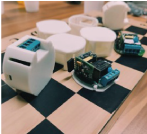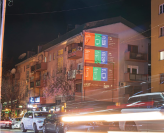Grantee:
SpaceSyntaKs
Challenge:
Energy
Project Name:
ENERGOMETER (www.energometer.org)
Location:
3 apartments in 1 building in central Pristina
Interview Quotes:
Gresa Neziri (primary), Donika Capriqi, Elira Galloki
Partnership(s):
ERO
The Innovation:
Projecting data on daily energy consumption from household appliances to help residents and observers understand how use contributes to costs to consumers.
Background:
SpaceSyntaKs started as a community of geo-data enthusiasts who came together to explore and exchange ideas and make use of geo-spatial data to improve quality of life.The Pristina-based research institute “conducts human-centered research to deepen the understanding of the link between urban phenomena with their socio-economic conditions.”
SpaceSyntaKs used the Dig Data Challenge to close the data gap on the link between energy consumption and energy bills.
The Call
Benefits of the Call
Dig Data Challenge support enabled SpaceSyntaKs to pursue plans to introduce a public display on household energy consumption inforrmation to demonstrate the link between energy use and cost.
The Response
SpaceSynaKs used a mixture of methods to provoke reflection and equip citizens with information and tools for practicing data driven decision making in regards to their household electricity footprint and expenses.

Design
ENERGOMETER included: 1) an electricity-saving behavioral experiment, 2) a digital platform to capture smart switch data and 3) a projection of residents’ energy consumption data on a building’s facade in central Pristina
WEB DESIGN:
SpaceSyntaKs designed a dashboard on their website for recording energy usage data to be collected by the smart switches.
BUILDING SELECTION:
SpaceSyntaKs identified “Building Zero” in central Pristina.
Smart switches installed in the apartments of participating families.
FAMILY RECRUITMENT:
Three families participated: a young couple, an older couple, and a family of four.
PAIN POINT:
COVID-19 affected the experiment. When building occupants contracted COVID, part of the building was quarantined, and SpaceSyntaKs substituted participants.
COVID-19 also delayed the start of the project.
Implementation
CAMPAIGN:
Three teaser trailers released on social media to engage the public.
Coincided with a change in regulations from ERO, which raised tariffs over a certain threshold. The app could alert families when they were approaching the threshold.

SMART SWITCHES:
Monitored daily energy use and identified which appliances were using the most power and when.

TRACKING:
Families could access their personalized energy usage data on a mobile app in real time.
Provided participants with a greater understanding of their energy bills and enabled them to monitor usage.

TIPS:
Usage patterns of one appliance were showcased each day to demonstrate how different behavior could reduce energy bills.

PROJECTION:
3 families’ energy data was projected onto the façade of “Building Zero” for one month.
The general public could observe the projected data throughout the month.
SpaceSyntaKs used the Dig Data Challenge to close the data gap on the link between energy consumption and energy bills by building awareness among both the building residents as well as anyone who observed the building’s exterior.
Completion
With the final results in July, SpaceSyntaKs will publish a full report with the project outcomes and datasets, as well as the 31 tips that emerged on how to optimize electricity consumption and expenditures.
Sustainability

Before we used international sensors, but now we use the sensors from ourselves and the government.”
The platform will continue to display realtime data from the 35 sensors for the public.
The boxes created under Breath Data are the first to source data locally and engage students and the community.
All information is in Albanian and is specific to their municipalities.